A quick and easy dish that doesn’t skimp on looks or flavor, pasta salmone e piselli (Pasta with Salmon and Peas) is a staple in our home. We have this or something similar for dinner just about weekly. Don’t ask me why I haven’t gotten around to posting a recipe for it in nearly 15 years of blogging… but anyway, it’s high time to correct the omission.
The recipe calls for just a few pantry staples—pasta, smoked salmon, frozen peas and cream—that at least in our house are always on hand. And it’s the kind of dish you can throw together and get on the table in the time it takes to bring water to the boil and cook your pasta. That makes it one of my go-tos for weekday dinners.
It’s a colorful, almost painterly dish, with its flecks of green and light pink set against a yellow background. And the taste? Salmon and peas also get along famously, if you ask me just as well as the better known pairing of peas and cured pork like ham, pancetta or prosciutto. And the cream—which doesn’t figure in many recipes but for me is an absolute must—adds luxurious mouthfeel and richness.
And as quick and easy as it is, there’s a touch of elegance to pasta salmone e piselli, so you can serve it not only as an everyday dish for family and friends, but as a starter to a special meal.
You might also like…
Fusilli primavera
I had always thought of “Pasta Primavera” as a modern American invention, probably a product of the rage for so-called “northern Italian” food in the 1970s and 1980s. I remember reading about it years ago in some gourmet magazine and asked my nonna Angelina to make me it for me. “What’s that?” she replied with a bemused chuckle. And in all my years there I’ve never actually come cross it in Italy, either.
So imagine my surprise, as I was leafing through my trusty copy of the classic La cucina napoletana, when I found a entry for fusilli primavera, described as the “personal recipe” of a well known chef named Gerardo Modugno. So even if there is no shortage of faux Italian dishes called Pasta Primavera, a truly Italian version of it really does exist. Or at least it did in the kitchen of a certain upper class Naples household in the mid 20th century.
For the most part, Italian cookery is about dishes that use a limited number of best-quality ingredients, simply but expertly prepared. I’ve written about how you should be wary of the authenticity of supposedly Italian recipes with a long list of ingredients and multiple steps. Well, my friends, this recipe is an exception that proves the rule. It calls for many ingredients and entails lots of different steps—and mind you, this is my streamlined version of the original!
But we shouldn’t be too surprised. This version of Pasta Primavera comes out of the tradition of French-inspired chefs that labored in the kitchens of the 18th and 19th century Neapolitan nobility, a class of chefs called the monzù. Modugno is apparently still alive and claims to be the last of the monzù. So no, this is not a quick and easy weeknight dinner dish, but it is truly, authentically Italian, steeped in culinary history.
Calamarata con Salsiccia, Ricotta e Piselli (Calamarata Pasta with Sausage, Ricotta and Peas)
This was a dish I made up on the spot one day, finding a few stray links of sausage and some leftover ricotta in my fridge, and some frozen peas at the bottom of the freezer, to dress some calamarata pasta I had in the pantry. The result was delicious!
I thought I had stumbled on a new classic, until I check it out on internet and found that, yes, the dish, or something very much like it, already exists. The dish, rigatoni alle salsicce e ricotta, is from Molise, one of the lesser known regions of Italy, on the Adriatic coast, south of Abruzzo and north of Puglia. Ah well, I can’t claim this dish as my own, I guess, but it’s still very good indeed.
Pasta e piselli (Pasta and Peas)
Here’s a when-you-really-don’t-feel-like-cooking dish. It’s a quick and easy combination of pasta and canned (yes canned!) peas, but really satisfying. Along with pasta e lenticchie, this was my favorite everyday pasta my nonna Angelina would make when I was a kid.
Cipolline novelle con piselli (Spring Onions and Peas)
While many recipes for peas call for a bit of onion as a flavor base, you don’t really taste the onion itself—it’s there to bring out the peas’ natural sweetness. In this recipe for Spring Onions and Peas, you get a completely new dish from essentially the same ingredients in different ratios. The onion steps up as an equal player, and the two make a beautiful duet, both visually and gustatorially.
Spring Onion and Peas is a great way to enjoy those true spring onions from your local farmers market. And while using young, tender, just-picked farm-fresh peas would also be ideal, fine frozen peas actually work just fine. Recipes usually call for olive oil only, but I find a dab of butter lends an appealing extra sweetness to the dish. Pancetta adds savor if you want, but as pictured here, I prefer pure vegetable version. And if you leave out the butter and optional pancetta from your Spring Onion and Peas, the dish is vegan.
With young, tender vegetables, this dish will take you barely 15 minutes to make—don’t overcook it, either, or the dish will lose its sweetness.
Piselli alla romana (Roman-Style Peas)
Now piselli alla romana may be the shortest recipe I ever write, as this tasty and elegant side dish is about as simple as you can get, short of boiling water. Just peas simmered in olive oil with onions and prosciutto. What could be easier? But it’s a classic of Roman cookery for a reason.
Spezzatino di vitello con piselli (Veal Stew with Peas)
Spring is finally here! And one of the great delights of this time of year in Italy is the appearance of tiny young vegetables the Italians call primizie. While in this era of year-round asparagus the seasons are not quite so discernible in our supermarkets, a few vegetables still retain their seasonality—like fresh peas. I saw some today and just knew I had to make something with them—and what better than a beautiful veal stew with peas? Of course, even if you don’t have fresh peas on hand, you can make this deliciously delicate stew with frozen peas as well.

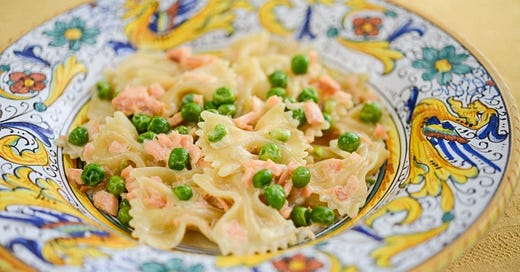



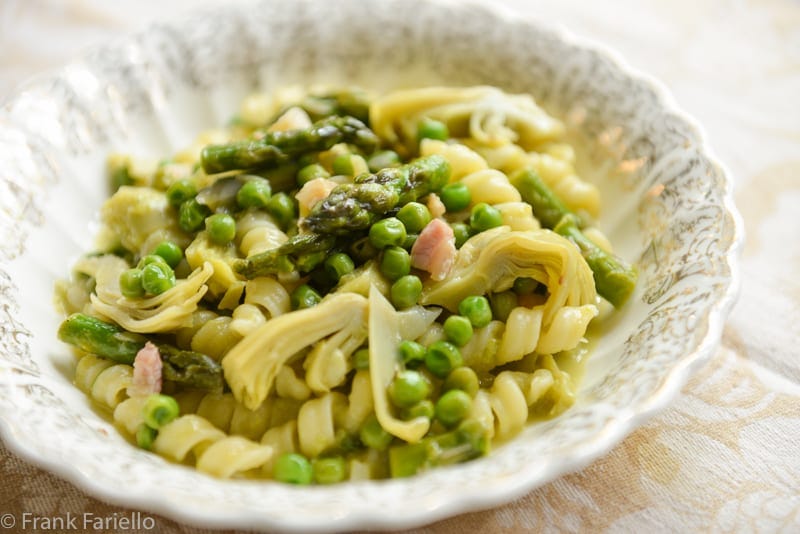

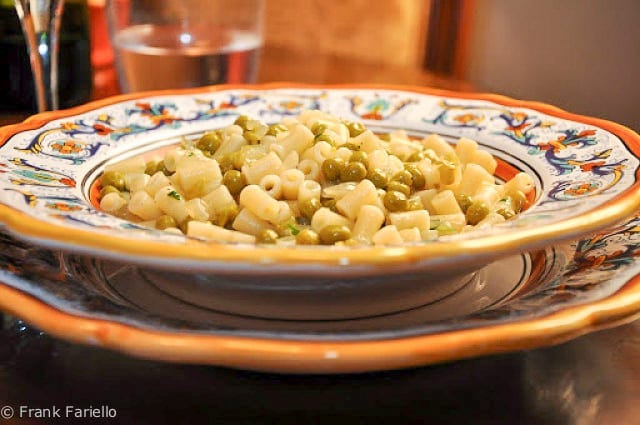
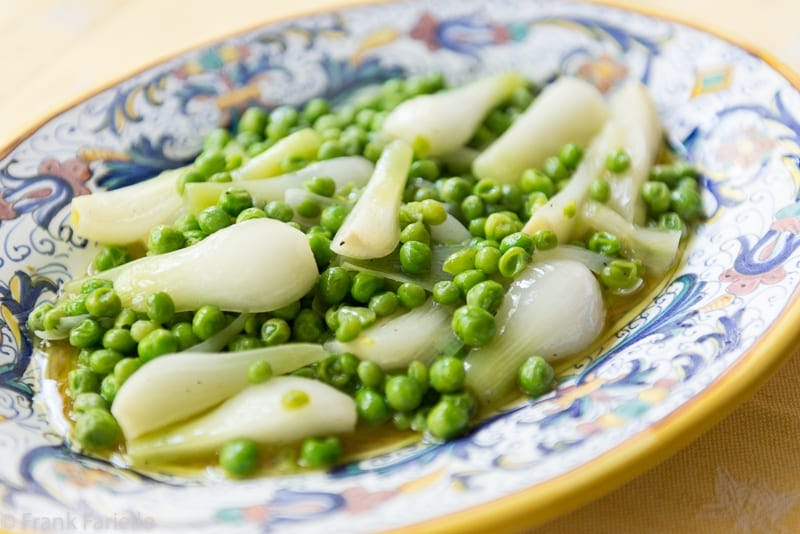
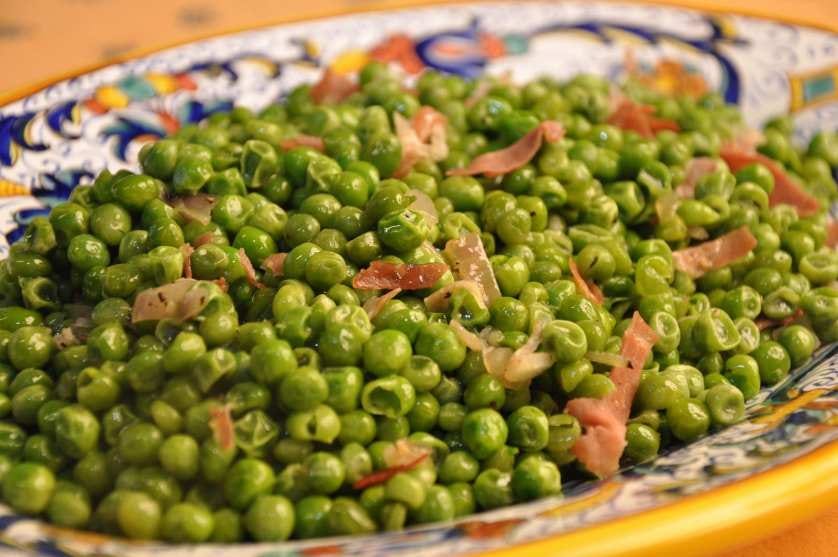

Terrific recipe! My wife adores smoked salmon, and this was a real hit with her. I did scale the recipe up a bit, to accommodate package sizes found in the supermarket (16 oz. farfalle instead of 14 oz.; 12 oz. smoked salmon instead of 10-1/2 oz.; 8 oz. frozen peas instead of 7 oz.), and used correspondingly larger shallots, but I kept the 1 c. heavy cream, and everything worked out fantastically. We did find that a little bit of grated parmagiano regggiano (although sacrilegious) added nice umami at the table. My wife wonders whether the dish might benefit from one additional herbal/vegetable note; she suggested capers, or dill, or spring onion. Any thoughts?